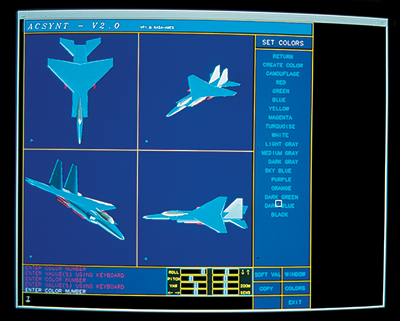Aircraft Design Software
Designing new civil air transportation has been made far easier thanks to aircraft design software that inspects, modifies, and integrates the engineering analysis process.
In the 1970s, Ames Research Center initiated an endeavor to greatly improve the conceptual design process. A software tool was developed to give aircraft builders the information they needed to rapidly and accurately forecast during early design phases an aircraft's performance and cost, even the noise it would generate.
Working closely with airframe and engine manufacturers, Ames formulated the AirCraft SYNThesis (ACSYNT) tool. In 1987, Ames and the Virginia Polytechnic Institute (Tech) CAD Laboratory in Blacksburg, Virginia, began to design and code a computer-aided design system for ACSYNT. In 1990, using a Joint Sponsored Research Agreement (JSRA), Ames formed an industry-government-university alliance to improve and foster research and development for the ACSYNT software. This ACSYNT Institute allowed NASA and Virginia Tech to develop and improve computer -aided aircraft design while receiving immediate feedback from industry users of ACSYNT software. American Technology Initiative (AmTech) of Menlo Park, California served as the organizing body for the JSRA, administrating contractual and licensing agreements.
The result? ACSYNT is becoming a predominant software tool for aircraft conceptual design. Moreover, this historical connection with the "customer" provided the foundation for commercializing ACSYNT.
ACSYNT Institute members included NASA's Ames, Lewis and Langley Research Centers and the Naval Weapons Center, as well as major U.S. airframe and engine manufacturers such as Boeing Commercial Airplane, Boeing Helicopter, General Electric Aircraft Engine, Lockheed, McDonnell Douglas, Northrop and Cessna. This alliance lets NASA pool funds and other resources with industry members to support strengthening of the software's capabilities. These enhancements were performed by the space agency and Virginia Tech CAD Laboratory.
From 1987 into 1995, the resulting ACSYNT research and development helped to shape and energize a market for a commercialization effort and the spawning of a new company.
Successful commercialization of ACSYNT has manifested itself in the creation of Phoenix Integration, Inc. of Blacksburg, Virginia. ACSYNT has been exclusively licensed to Phoenix Integration, an outcome of a seven year, $3 million effort to provide unique software technology to a focused design engineering market.
ACSYNT has become a top-notch conceptual level aircraft design tool that provides a 3D computer-aided design (CAD) environment coupled with detailed analysis capabilities. An aircraft concept can be quickly modeled in the CAD interface, and then analyzed using a suite of multidisciplinary modules representing aerodynamic, propulsion, and mission performance parameters. ACSYNT has been successfully applied to high-speed civil transport configurations, subsonic transports, and supersonic fighters.
Phoenix Integration is now marketing, distributing, enhancing and maintaining ACSYNT. The start-up firm has already pioneered Dynamic Integration System™ (DIS) technology, as well as an extensive set of easy-to-use, motif -based tools that interact with any analysis that supports the DIS interface.
It is a Phoenix Integration credo that streamlining the engineering process through more advanced design tools is critical in today's demanding and competitive world. However, recent trends in down-sizing have meant many engineering firms cannot afford to pay engineers to spend time developing software. Phoenix Integration has tackled this dilemma by offering software specifically designed for engineers and at costs far below that if the software was created from inside a company.
Research and development of ACSYNT which, in turn, led to this successful commercialization story, is a blend of innovative technology, a viable market, and leadership to direct the effort.
Dynamic Integration System is a trademark of Phoenix Integration, Inc.

Using ACSYNT by Phoenix Integration, aircraft designers may enter the dimensions of components and have surfaces created automatically.













